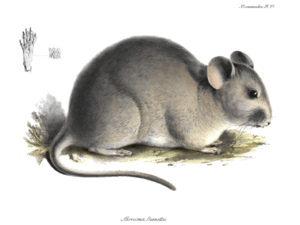Bennett's chinchilla rat facts for kids
Quick facts for kids Bennett's chinchilla rat |
|
|---|---|
 |
|
| Conservation status | |
| Scientific classification | |
| Genus: |
Abrocoma
|
| Species: |
bennettii
|
The Bennett's chinchilla rat (scientific name: Abrocoma bennettii) is a special type of chinchilla rat. It belongs to a family of rodents called Abrocomidae. You can only find this animal in Chile, a country in South America. It lives in areas with Mediterranean-style bushes and plants, especially on the western side of the Andes mountains. Experts at the IUCN say that this rat is a "least concern" species. This means it is not currently in danger of disappearing.
What Does It Look Like?
Bennett's chinchilla rat is the biggest type of chinchilla rat in its group. Its body, from head to tail, is about 20.6 centimeters (8 inches) long. Its tail is also quite long, about 80% of its body length.
Like other chinchilla rats, it has very soft, thick fur. Its ears are easy to see and are round. Its feet are wide but short. It has four toes on its front feet and five on its back feet. The small, nail-like claws on its feet are hidden by stiff, brush-like hairs.
The fur on its back is dark brown with a hint of grey. It's a bit lighter on its sides. The fur on its belly has dark grey bases and light grey tips. This makes its belly look a bit "frosted," which helps tell it apart from other chinchilla rats that have lighter bellies. Its tail is covered in fur and is the same color all over. The tops of its front and back feet have whitish fur, while the bottoms are dark but have no fur. Some of these rats have a patch of white hairs on their chest, which shows where a special gland is located.
How It Lives
Bennett's chinchilla rat is a nocturnal animal. This means it is active mostly at night. During the day, it sleeps in a burrow.
Sometimes, it shares burrows that are already dug by other animals. These can include the common degu (Octodon degus), the Chilean rock rat (Aconaemys fuscus), or the long-tailed chinchilla (Chinchilla lanigera). If it can't find a shared burrow, it will dig its own. It often digs its burrows under large rocks.
This chinchilla rat is very good at climbing. It can climb both rocks and bushes easily. It eats different parts of plants, such as young shoots, leaves, grasses, and seeds.
Its Home and Safety
Bennett's chinchilla rat lives in a large area in Chile. It can be found on the western slopes of the Andes mountains, living at heights of up to about 2,000 meters (6,560 feet).
Its home is changing because some land is being used for farming or mining. However, this chinchilla rat lives in several protected areas. The number of these rats is not going down very quickly. Because of this, the International Union for Conservation of Nature has decided that its conservation status is "least concern". This means it is not currently at high risk of becoming extinct.
See also

- In Spanish: Rata chinchilla de Bennett para niños


